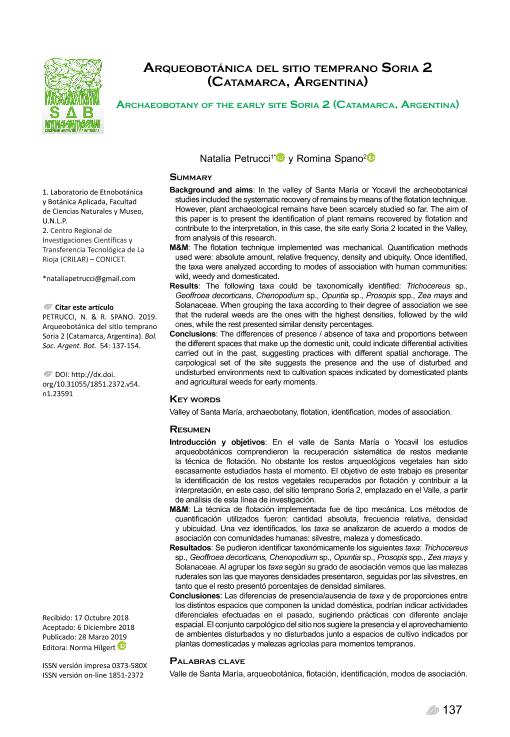Artículo
Background and aims: In the valley of Santa María or Yocavil the archeobotanical studies included the systematic recovery of remains by means of the flotation technique. However, plant archaeological remains have been scarcely studied so far. The aim of this paper is to present the identification of plant remains recovered by flotation and contribute to the interpretation, in this case, the site early Soria 2 located in the Valley, from analysis of this research. M&M: The flotation technique implemented was mechanical. Quantification methods used were: absolute amount, relative frequency, density and ubiquity. Once identified, the taxa were analyzed according to modes of association with human communities: wild, weedy and domesticated. Results: The following taxa could be taxonomically identified: Trichocereus sp., Geoffroea decorticans, Chenopodium sp., Opuntia sp., Prosopis spp., Zea mays and Solanaceae. When grouping the taxa according to their degree of association we see that the ruderal weeds are the ones with the highest densities, followed by the wild ones, while the rest presented similar density percentages. Conclusions: The differences of presence / absence of taxa and proportions between the different spaces that make up the domestic unit, could indicate differential activities carried out in the past, suggesting practices with different spatial anchorage. The carpological set of the site suggests the presence and the use of disturbed and undisturbed environments next to cultivation spaces indicated by domesticated plants and agricultural weeds for early moments. Introducción y objetivos: En el valle de Santa María o Yocavil los estudios arqueobotánicos comprendieron la recuperación sistemática de restos mediante la técnica de flotación. No obstante los restos arqueológicos vegetales han sido escasamente estudiados hasta el momento. El objetivo de este trabajo es presentar la identificación de los restos vegetales recuperados por flotación y contribuir a la interpretación, en este caso, del sitio temprano Soria 2, emplazado en el Valle, a partir de análisis de esta línea de investigación. M&M: La técnica de flotación implementada fue de tipo mecánica. Los métodos de cuantificación utilizados fueron: cantidad absoluta, frecuencia relativa, densidad y ubicuidad. Una vez identificados, los taxa se analizaron de acuerdo a modos de asociación con comunidades humanas: silvestre, maleza y domesticado. Resultados: Se pudieron identificar taxonómicamente los siguientes taxa: Trichocereus sp., Geoffroea decorticans, Chenopodium sp., Opuntia sp., Prosopis spp., Zea mays y Solanaceae. Al agrupar los taxa según su grado de asociación vemos que las malezas ruderales son las que mayores densidades presentaron, seguidas por las silvestres, en tanto que el resto presentó porcentajes de densidad similares. Conclusiones: Las diferencias de presencia/ausencia de taxa y de proporciones entre los distintos espacios que componen la unidad doméstica, podrían indicar actividades diferenciales efectuadas en el pasado, sugiriendo prácticas con diferente anclaje espacial. El conjunto carpológico del sitio nos sugiere la presencia y el aprovechamiento de ambientes disturbados y no disturbados junto a espacios de cultivo indicados por plantas domesticadas y malezas agrícolas para momentos tempranos.
Arqueobotánica del sitio Soria 2 (Catamarca, Argentina)
Título:
Archaeobotany of the early site Soria 2 (Catamarca, Argentina)
Fecha de publicación:
03/2019
Editorial:
Sociedad Argentina de Botánica
Revista:
Boletín de la Sociedad Argentina de Botánica
ISSN:
0373-580X
e-ISSN:
1851-2372
Idioma:
Español
Tipo de recurso:
Artículo publicado
Clasificación temática:
Resumen
Archivos asociados
Licencia
Identificadores
Colecciones
Articulos(CRILAR)
Articulos de CENTRO REGIONAL DE INV. CIENTIFICAS Y TRANSFERENCIA TECNOLOGICA DE ANILLACO
Articulos de CENTRO REGIONAL DE INV. CIENTIFICAS Y TRANSFERENCIA TECNOLOGICA DE ANILLACO
Citación
Petrucci, Natalia Silvana; Spano, Romina Clara; Arqueobotánica del sitio Soria 2 (Catamarca, Argentina); Sociedad Argentina de Botánica; Boletín de la Sociedad Argentina de Botánica; 54; 1; 3-2019; 137-154
Compartir
Altmétricas




